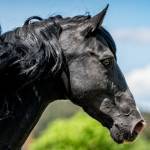Caseins Contribute to Stallion Fertility

Many stallions experience periods of decreased fertility, a natural occurrence, during the breeding season. Semen protein analysis recently identified 38 proteins that fluctuate during periods of high and low fertility. One group of proteins called caseins piqued the interest of researchers as their levels increased when stallions were most fertile.
“The abbreviated breeding season, delayed pregnancy diagnosis (about two weeks after breeding), and natural fluctuations of stallion fertility during the breeding season can all contribute to impaired breeding parameters, resulting in economic losses and welfare issues for breeding stock,” explained Kathleen Crandell, Ph.D., a nutritionist for Kentucky Equine Research.
Many research groups are exploring various techniques to determine what causes the transient periods of stallion subfertility during the breeding season. One group recently used “proteomic technology” to identify specific proteins present in semen samples, with the goal of determining which proteins change in abundance during various phases of fertility.
That team collected 1,030 semen samples from dozens of stallions over several breeding seasons. Comprehensive protein analyses, called proteomics, identified 38 proteins that were significantly different between times of high and low fertility.
The research team was particularly intrigued by a group of proteins called caseins that were more abundant during times of high fertility.
“According to the study, caseins preserve membrane stability, including support of the outer membrane of the sperm that must remain intact to successfully fertilize an egg. During periods of high fertility, caseins protect spermatozoa from reactive oxygen species as well as deleterious proteins like seminal plasma proteins,” explained Crandell.
Together with other key proteins, caseins play a role in short-term fluctuations in stallion fertility and open new avenues to improve reproductive parameters.
“Being able to rapidly identify a stallion’s subfertile periods during the breeding season would allow breeders the opportunity to change strategies: identify the need for an alternate stallion more quickly or arrange for repeated breedings by the subfertile stallion during the same estrous period,” explained Crandell.
For nutritional support of stallions during the breeding season, Crandell recommends marine-derived omega-3 fatty acids DHA and EPA, such as those found in EO-3.
“Research shows that these fatty acids improve the performance of subfertile stallions by increasing sperm concentration, motility, and viability,” Crandell said.
*Griffin, R.A., A. Swegen, M.A. Baker, R.A. Ogle, M. Smith, R.J. Aitken, D.A. Skerrett-Byrne, S. Fair, and Z. Gibb. 2022. Proteomic analysis of spermatozoa reveals caseins play a pivotal role in preventing short-term periods of subfertility in stallions. Biology of Reproduction 106(4):741-755.








